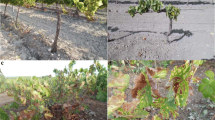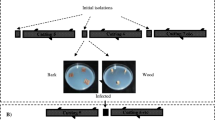Abstract
Grapevine trunk disease pathogens, and specifically Petri disease pathogens, can be spread by planting infected plants. Due to the increasing incidence of Petri disease and other young grapevine declines reported lately in Spain, a sampling of plants used before for new vineyards were carried out in 2002 and 2004. A total number of 208 plants (grafted and non grafted) were collected, of which 94 plants (45.2%) were infected with at least one of the following pathogens: Phaeomoniella chlamydospora, and species of Phaeoacremonium, Botryosphaeria, Cylindrocarpon, and Phomopsis. Species of the genera Phaeoacremonium and Botryosphaeria isolated in 2004 were identified using morphological and molecular characters. Species of Phaeoacremonium identified were P. aleophilum and P. parasiticum; and those of Botryosphaeria were B. obtusa, B. dothidea and B. parva. This is the first report of P. parasiticum and B. parva occurring on grapevines in Spain. Distribution of pathogens within the plants was studied in 2004. Phaeomoniella chlamydospora was not detected in the graft union of any plant; however, species of Botryosphaeria and Phomopsis were detected along the plant, but mainly in the graft union; Phaeoacremonium aleophilum was detected along the grafted plants, but not in rooted rootstocks. The results suggest that infected plants used for new plantings in Spain are an important source of primary inoculum of the pathogens associated with grapevine trunk diseases in the field.
Similar content being viewed by others

References
Armengol J, Vicent A, Torné L, García-Figueres F, García-Jiménez J (2001) Fungi associated with esca and grapevine declines in Spain: A three-year survey. Phytopathologia Mediterranea 40: 325–329
Armengol J, Vicent A, García-Jiménez J (2002) El decaimiento y muerte de vides jóvenes (Enfermedad de Petri) en España. Phytoma España 138: 91–93
Auger J, Pérez I, Esterio M, Navia V, Gubler WD and Eskalen A (2005) Fungi associated with grapevine wood decay and young vine decline in Chile. In: 4th International Workshop on grapevine trunk disease (pp. 25). Stellenbosch, South Africa
Bertelli E, Mugnai L, Surico G (1998) Presence of Phaeoacremonium chlamydosporum in apparently healthy rooted grapevine cuttings. Phytopathotogia Mediterranea 37: 79–82
Castillo-Pando M, Somers A, Green CD, Priest M, Sriskathades M (2001) Fungi associated with dieback of Semillon grapevines in the Hunter Valley of New South Wales. Australasian Plant Pathology 30: 59–63
Crous P, Gams W (2000) Phaeomoniella chlamydospora gen. et. comb. nov., a causal organism of Petri grapevine decline and esca. Phytopathologia Mediterranea 39: 112–118
Crous PW, Gams W, Wingfield MJ, Van Wyk PS (1996) Phaeoacremonium gen. nov. associated with wilt and decline diseases of woody host and human infections. Mycologia 88: 786–796
Dubos B (2002) Maladies cryptogamiques de la vigne. Éditions Féret, Bourdeaux, Francia
Dupont J, Laloui W, Magnin S, Larignon P, Roquebert MF (2000) Phaeoacremonium viticola, a new species associated with Esca disease of grapevine in France. Mycologia 92(3): 499–504
Edwards J, Pascoe IG (2004) Occurrence of Phaeomoniella chlamydospora and Phaeoacremonium aleophilum associated with Petri disease and esca in Australian grapevines. Australasian Plant Pathology 33: 273–279
Eskalen A, Tooney-Latham S and Gubler WD (2005) Occurrence of Togninia fraxinopennsylvanica perithecia and Phaeoacremonium species in California vineyards. In: 4th International Workshop on Grapevine Disease (pp.13). Stellenbosch, South Africa
Fourie PH, Halleen F (2004) Occurrence of grapevine trunk disease pathogens in rootstock mother plants in South Africa. Australasian Plant Pathology 33: 313–315
Gardes M, Bruns TD (1993) ITS primers with enhanced specificity for Basidiomycetes: Application to the identification of mycorrhizae and rusts. Molecular Ecology 2(2): 113–118
Groenewald M, Kang J-C, Crous PW (2001) ITS and β tubulin phylogeny of Phaeoacremonium and Phaeomoniella species. Mycological Research 105(6): 651–657
Halleen F, Crous PW, Petrini O (2003) Fungi associated with healthy grapevine cuttings in nurseries, with special reference to pathogens involved in the decline of young vines. Australasian Plant Pathology 32: 47–52
Halleen F, Schroers H-J, Groenewald JZ, Crous PW (2004) Novel species of Cylindrocarpon (Neonectria) and Campylocarpon gen. nov. associated with black foot disease of grapevines (Vitis spp.). Studies in Mycology 50: 431–455
Ker-Chung K, Lii-Sin L (1998) Phomopsis vitimegaspora: A new pathogenic Phomopsis from vines. Mycotaxon 65: 497–499
Larignon P, Dubos B (1997) Fungi associated with esca disease in grapevine. European Journal of Plant Pathology 103: 147–157
Larignon P, Dubos B (2001) Le Black Dead Arm: Maladie nouvelle à ne pas confondre avec l´Esca. Phytoma 5: 30–31
Maluta D, Larignon P (1991) Pied-noir: Mieux vaut prevenir. Viticulture 11: 71–72
Merrin S, Nair NG, Tarran J (1995) Variation in Phomopsis recorded on grapevine in Australia and its taxonomic and biological implications. Australasian Plant Pathology 24: 44–56
Mostert L, Groenewald JZ, Gams W, Summerbell RC, Robert V and Crous PW (2005) Delimitation of new species in Pheoacremonium and the development of an identification system. In: 4th International Workshop on Grapevine Trunk Diseases (IWGTD) (pp. 12). Stellenbosh, Stellenbosch, South Africa
Mugnai L, Graniti A, Surico G (1999) Esca (Black Measles) and brown wood-streaking: Two old and elusive diseases of grapevines. Plant Disease 83: 404–418
Niekerk van J, Crous PW, Groenewald JZ, Fourie PH, Halleen F (2004) DNA phylogeny, morphology and pathogenicity of Botryosphaeria species on grapevines. Mycologia 96(4): 781–798
Niekerk van J, Groenewald JZ, Farr DF, Fourie PH, Halleen F and Crous PW (2005) Phomopsis spp. on grapevines: Characterisation and pathogenicity. In: 4th International Workshop on Grapevine Trunk Diseases (IWGTD) (pp. 30). Stellenbosh, Stellenbosch, South Africa
Overton B, Stewart EL and Wenner NG (2005) Molecular phylogenetics of grapevine decline fungi from Pennsylvania and New York. In: 4th International Workshop on Grapevine Trunk Disease (pp. 27). Stellenbosch, South Africa
Pearson RC, Goheen AC (1994a) Phomopsis cane blight and leaf spot. In: Pearson RC, Goheen AC (eds) Compendium of Grape Diseases. APS Press, St. Paul (MN), USA, pp. 17–18
Pearson RC, Goheen AC (1994b) Compendium of Grape Diseases. APS Press, St. Paul (MN), USA
Pennycook S, Samuels GJ (1985) Botryosphaeria and Fusicoccum species associated with ripe fruit rot of Actinidia deliciosa (kiwifruit) in New Zealand. Mycotaxon 24: 445–458
Phillips AJL (2000) Excoriose, cane blight and related diseases of grapevines: A taxonomic review of the pathogens. Phytopathologia Mediterranea 39(3): 341–346
Phillips AJL (2002) Botryosphaeria species associated with diseases of grapevines in Portugal. Phytopathologia Mediterranea 41: 3–18
Rego C, Oliveira H, Carvalho A, Phillips A (2000) Involvement of Phaeoacremonium spp. and Cylindrocarpon destructans with grapevine decline in Portugal. Phytopathologia Mediterranea 39: 76–79
Scheck H, Vasquez SJ, Gubler WD (1998a) First report of Black-Foot Disease, caused by Cylindrocarpon obtusisporum, of grapevine in California. Plant Disease 82: 448
Scheck H, Vasquez SJ, Fogle D, Gubler WD (1998b) Grape growers report losses to black-foot and grapevine decline. California Agriculture 52(4): 19–23
Slippers B, Crous PW, Benman S, Coutinho TA, Wingfield BD, Wingfield MJ (2004) Combined multiple gene genealogies and phenotypic characters differentiate several species previously identified as Botryosphaeria dothidea. Mycologia 96(1): 83–101
Sparapano L, Bruno G, Ciccarone C, Graniti A (2000) Infection of grapevines by some fungi associated with esca. II. Interaction among Phaeoacremonium chlamydosporum, Phaeomoniella aleophilum and Fomitiporia punctata. Phytopathologia Mediterranea 39: 125–133
Surico G (2001) Towards commonly agreed answers to some basic questions on esca. Phytopathologia Mediterranea 40: S487–S490
Uecker F, Ker-Chung K (1992) A new Phomopsis with long paraphyses. Mycotaxon 64: 425–433
Whiteman S, Jaspers MV, Stewart A, Ridgway HJ (2003a) Identification of potenctial sources of Phaeomoniella chlamydospora in the grapevine propagation process. Phytophathologia Mediterranea 43: 152–153
Acknowledgements
The authors thank A. Bernao and Viticulture Cooperatives for help in sampling plants. This research was supported by Project RTA03-058-C2 (Programa Nacional de Recursos y Tecnologías Agrarias, Ministerio de Educación y Ciencia, Spain). Angeles Aroca was supported by a grant from INIA.
Author information
Authors and Affiliations
Corresponding author
Rights and permissions
About this article
Cite this article
Aroca, A., García-Figueres, F., Bracamonte, L. et al. A Survey of Trunk Disease Pathogens within Rootstocks of Grapevines in Spain. Eur J Plant Pathol 115, 195–202 (2006). https://doi.org/10.1007/s10658-006-9008-5
Received:
Accepted:
Published:
Issue Date:
DOI: https://doi.org/10.1007/s10658-006-9008-5



